Jo Mora
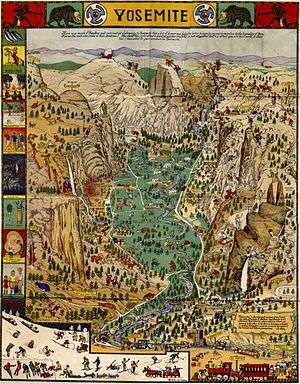
Joseph Jacinto "Jo" Mora (October 22, 1876 – October 10, 1947) was a Uruguayan-born American cartoonist, illustrator and cowboy, who lived with the Hopi and wrote extensively about his experiences in California. He was an artist-historian, sculptor, painter, photographer, illustrator, muralist and author. He has been called the "Renaissance Man of the West".
Biography
Mora was born on October 22, 1876 in Montevideo, Uruguay. His father was the Catalonian sculptor, Domingo Mora, and his mother was Laura Gaillard Mora, an intellectual born in the Bordeaux region of France. His elder brother was F. Luis Mora, who would become an acclaimed artist and the first Hispanic member of the National Academy of Design. The family entered the United States in 1880 and first settled in New York City, and then Perth Amboy, New Jersey. Jo Mora studied art at the Art Students League of New York and the Cowles School in Boston. He also studied with William Merritt Chase. In Boston, he worked as a cartoonist for a newspaper called the Boston Evening Traveller and then worked for the Boston Herald.
In the spring of 1903, Mora arrived in Solvang, California. He stayed at the Donohue Ranch. He made plans to travel to the Southwest to paint and photograph the Hopi. He spent time at the Mission Santa Inés; those photographs are now maintained by the Smithsonian Institution. Mora visited many Spanish missions in California that summer by horseback. He followed the "Mission Trail", also called the "Kings Highway".
From 1904 to 1906, Mora lived with the Hopi and Navajo near Oraibi, Arizona. He took photographs, painted and otherwise recorded the daily life of these Native Americans, including the Hopi Snake Dance. He learned the Native languages and made detailed drawings of what he observed.[1]
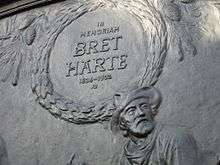
In 1907, Mora returned to California and married Grace Needham. Their son, Joseph Needham Mora, was born on March 8, 1908. The Moras moved to San Jose, California, where Mora continued his work. In 1915 he served on the International Jury of Awards at the Panama-Pacific International Exposition and displayed six sculptures.[2] In 1915-16 two of his most important sculptural commissions were revealed: the bronze memorial tablet with the profile of the late Archbishop Patrick W. Riordan for the Knights of Columbus and the Cervantes Monument in San Francisco’s Golden Gate Park.[3][4] By 1919, he was sculpting for the Bohemian Club, including a memorial plaque dedicated to Bret Harte, completed in August 1919 and mounted on the outside of the private men's club building in San Francisco. In 1925, he designed the commemorative half dollar for the California Diamond Jubilee. During this period he also illustrated a number of books, made large murals, and published charts, maps (cartes) and diagrams of the West and Western themes. Beginning in 1937, Mora wrote and illustrated children's books about the West. In 1939, a Works Progress Administration project was completed, with Mora bas-relief sculpture adorning the King City High School Auditorium building.
In 1921 the Mora family moved their primary residence to the largest art colony on the West Coast, Carmel-by-the-Sea. Here Jo receive the most important commission of his career, the creation of the monumental bronze and travertine sarcophagus and altar for Father Junípero Serra to be placed at the west end of the Mission Carmel church.[2] He was extremely active in the Carmel community and served on the board of directors of the Carmel Art Association, where his sculptures were exhibited between 1927 and 1934. He co-established Carmel’s first private art gallery which was operated by resident artists.[5] In 1931 Jo, his wife, and daughter Patricia moved to nearby Pebble Beach into a newly built home. Five years later in the adjoining large studios he completed his massive diorama, Discovery of the San Francisco Bay by Portola, for the California Pavilion at the 1939-40 Golden Gate International Exposition on Treasure Island. At a length of almost 100 feet, with 64 sculptures of Spaniards and Indians and over 200 animals, it was said “to surpass anything of its kind at the Fair.”[6][7] He fashioned smaller dioramas for the Will Rogers Memorial Museum in Claremore, Oklahoma and the Sutter’s Fort Museum in Sacramento, California.[8][9]
Between 1908 and the late 1940s his sculptures, illustrations, watercolors and etchings were frequently exhibited across the United States.[2] Mora died October 10, 1947, in Monterey, California. His last book, Californios, which was devoted to the life of the rancheros of Alta California, was published posthumously in New York City to great acclaim.[10][11]
In music
- Western performer Mike Beck's album Where the Green Grass Grows includes a song about Mora entitled "In Old California". It was written by Beck and Ian Tyson.
- The rock group The Byrds used images from a 1932 Mora poster, The American Cowboy Rodeo, as the cover art for their album Sweetheart of the Rodeo.[12]
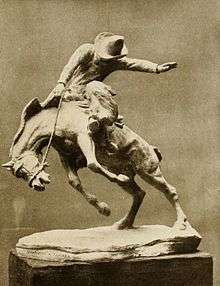 Scratching A Twister, 1915 |
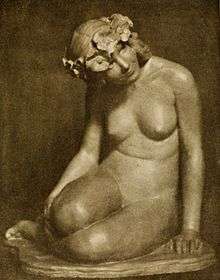 Poppy Girl, 1915 |
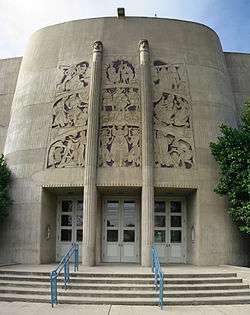 The facade of the Robert Stanton Theater at King City High School in King City, California. Completed in 1939, this Works Progress Administration project featured bas-relief sculpture by Jo Mora |
References
- ↑ Pecina, Ron and Pecina, Bob. Neil David’s Hopi World. Schiffer Publishing Ltd., 2011. ISBN 978-0-7643-3808-3; pp.8,9,54,55.
- 1 2 3 Edwards, Robert W. (2012). Jennie V. Cannon: The Untold History of the Carmel and Berkeley Art Colonies, Vol. 1. Oakland, Calif.: East Bay Heritage Project. pp. 191, 265, 522–525, 690. ISBN 9781467545679. An online facsimile of the entire text of Vol. 1 is posted on the Traditional Fine Arts Organization website (http://www.tfaoi.com/aa/10aa/10aa557.htm).
- ↑ The Oakland Tribune, 5 September 1915, p. 19.
- ↑ The Wasp (San Francisco, CA), 9 September 1916, p. 11.
- ↑ Carmel Pine Cone: 12 June 1931, p.2; 7 August 1931, p.7.
- ↑ The Oakland Tribune, 13 October 1938, p. 4; 25 June 1939, p.B-7.
- ↑ Carmel Pine Cone, 21 October 1938, p.10.
- ↑ The Carmel Cymbal, 27 September 1940, p. 6.
- ↑ The Oakland Tribune, 24 August 1946, p. 1-C.
- ↑ New York Times: 20 June 1949, p. 17; 26 June 1949, p.BR-10.
- ↑ Los Angeles Times, 10 July 1949, p. 4-5.
- ↑ "Californios Resplandores". Fred Smoot. Retrieved 2008-12-14.
Bibliography
- A Log of the Spanish Main (1934) OCLC 57523092 ASIN B00085UYN0.
- Trail Dust and Saddle Leather (1946) ISBN 0-8032-8145-5.
- Californios: The Saga of the Hard-Riding Vaqueros, America's First Cowboys (1949) ISBN 0-922029-19-9.
- When I Get Wound Up Writing I'm a Bad Article to Squelch: The Written Words of Jo Mora (2008) ISBN 0-615-23139-X.
Museum Catalogs
- The Year of the Hopi: Paintings and Photographs by Joseph Mora, 1904-'06, Smithsonian Institution, Washington, D. C., 1979
- Jo Mora: Artist and Writer, Monterey Museum of Art, 1998
- Back to the Drawing Board with Artist Jo Mora, Monterey History and Art Association, Monterey, CA, 2003
External links
- Komanecky, Michael K.: Jo Mora and the Missions of California, in: Anales del Instituto de Investigaciones Esteticas, Vol. 91, 2007, 207- 217
- Jo Mora Trust site
- Profile by Monterey Museum of Art
- California Views: The Pat Hathaway Photo Collection - Jo Mora
- Jo Mora Hopi Indian Photograph Collection
- Cline Library Jo Mora Photo Collection
- Californios
- Carmel Mission, Mora Chapel
- Brief profile of Mora
- The Ohio State University Billy Ireland Cartoon Library & Museum: Joseph Jacinto Mora